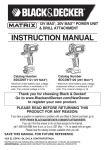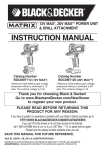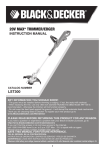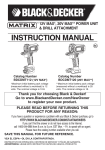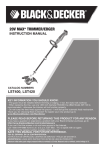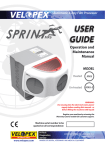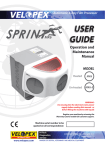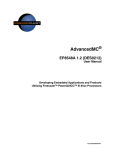Download Black & Decker 20v max reciprocating saw Instruction manual
Transcript
20v max* reciprocating saw INSTRUCTION MANUAL Catalog Number BDCR20 (20V MAX*) Thank you for choosing Black & Decker! To register your new product, go to www.BlackandDecker.com/NewOwner Please read before returning this product for any reason. If you have a question or experience a problem with your Black & Decker purchase, go to http://www.blackanddecker.com/instantanswers If you can’t find the answer or do not have access to the Internet, call 1-800-544-6986 from 8 a.m. to 5 p.m. EST Mon. - Fri. to speak with an agent. Please have the catalog number available when you call. Save this manual for future reference. VEA EL ESPANOL EN LA CONTRAPORTADA. INSTRUCTIVO DE OPERACIÓN, CENTROS DE SERVICIO Y PÓLIZA DE GARANTÍA. ADVERTENCIA: LÉASE ESTE INSTRUCTIVO ANTES DE USAR EL PRODUCTO. *Maximum initial battery pack voltage (measured without a workload) is 20 volts. Measured under a workload, nominal voltage is 18. A 9 5 F 2 1 8 4 3 7 6 G B C H D I E J 2 SAFETY GUIDELINES - DEFINITIONS It is important for you to read and understand this manual. The information it contains relates to protecting YOUR SAFETY and PREVENTING PROBLEMS. The symbols below are used to help you recognize this information. DANGER: Indicates an imminently hazardous situation which, if not avoided, will result in death or serious injury. WARNING: Indicates a potentially hazardous situation which, if not avoided, could result in death or serious injury. CAUTION: Indicates a potentially hazardous situation which, if not avoided, may result in minor or moderate injury. NOTICE: Used without the safety alert symbol indicates potentially hazardous situation which, if not avoided, may result in property damage. WARNING: Read all safety warnings and all instructions. Failure to follow the warnings and instructions may result in electric shock, fire and/or serious injury. Save all warnings and instructions for future reference The term “power tool” in the warnings refers to your mainsoperated (corded) power tool or battery-operated (cordless) power tool. cord away from heat, oil, sharp edges or moving parts. Damaged or entangled cords increase the risk of electric shock. e) When operating a power tool outdoors, use an extension cord suitable for outdoor use. Use of a cord suitable for outdoor use reduces the risk of electric shock. f) If operating a power tool in a damp location is unavoidable, use a ground fault circuit interrupter (GFCI) protected supply. Use of a GFCI reduces the risk of electric shock. 3) Personal safety a) Stay alert, watch what you are doing and use common sense when operating a power tool. Do not use a power tool while you are tired or under the influence of drugs, alcohol or medication. A moment of inattention while operating power tools may result in serious personal injury. b) Use personal protective equipment. Always wear eye protection. Protective equipment such as dust mask, nonskid safety shoes, hard hat, or hearing protection used for appropriate conditions will reduce personal injuries. c) Prevent unintentional starting. Ensure the switch is in the off position before connecting to power source and/ or battery pack, picking up or carrying the tool. Carrying power tools with your finger on the switch or energizing power tools that have the switch on invites accidents. d) Remove any adjusting key or wrench before turning the power tool on. A wrench or a key left attached to a rotating part of the power tool may result in personal injury. e) Do not overreach. Keep proper footing and balance at all times. This enables better control of the Save these instructions 1) Work Area Safety a) Keep work area clean and well lit. Cluttered or dark areas invite accidents. b) Do not operate power tools in explosive atmospheres, such as in the presence of flammable liquids, gases or dust. Power tools create sparks which may ignite the dust or fumes. c) Keep children and bystanders away while operating a power tool. Distractions can cause you to lose control. 2) Electrical safety a) Power tool plugs must match the outlet. Never modify the plug in any way. Do not use any adapter plugs with earthed (grounded) power tools. Unmodified plugs and matching outlets will reduce risk of electric shock. b) Avoid body contact with earthed or grounded surfaces such as pipes, radiators, ranges and refrigerators. There is an increased risk of electric shock if your body is earthed or grounded. c) Do not expose power tools to rain or wet conditions. Water entering a power tool will increase the risk of electric shock. d) Do not abuse the cord. Never use the cord for carrying, pulling or unplugging the power tool. Keep 3 power tool in unexpected situations. f) Dress properly. Do not wear loose clothing or jewelry. Keep your hair, clothing and gloves away from moving parts. Loose clothes, jewelry or long hair can be caught in moving parts. g) If devices are provided for the connection of dust extraction and collection facilities, ensure these are connected and properly used. Use of dust collection can reduce dust-related hazards. 4) Power tool use and care a) Do not force the power tool. Use the correct power tool for your application. The correct power tool will do the job better and safer at the rate for which it was designed. b) Do not use the power tool if the switch does not turn it on and off. Any power tool that cannot be controlled with the switch is dangerous and must be repaired. c) Disconnect the plug from the power source and/or the battery pack from the power tool before making any adjustments, changing accessories, or storing power tools. Such preventive safety measures reduce the risk of starting the power tool accidentally. d) Store idle power tools out of the reach of children and do not allow persons unfamiliar with the power tool or these instructions to operate the power tool. Power tools are dangerous in the hands of untrained users. e) Maintain power tools. Check for misalignment or binding of moving parts, breakage of parts and any other condition that may affect the power tool’s operation. If damaged, have the power tool repaired before use. Many accidents are caused by poorly maintained power tools. f) Keep cutting tools sharp and clean. Properly maintained cutting tools with sharp cutting edges are less likely to bind and are easier to control. g) Use the power tool, accessories and tool bits, etc. in accordance with these instructions, taking into account the working conditions and the work to be performed. Use of the power tool for operations different from those intended could result in a hazardous situation. 5) Battery tool use and care a)Recharge only with the charger specified by the manufacturer. A charger that is suitable for one type of battery pack may create a risk of fire when used with another battery pack. b)Use power tools only with specifically designated battery packs. Use of any other battery packs may create a risk of injury and fire. c)When battery pack is not in use, keep it away from other metal objects like paper clips, coins, keys, nails, screws, or other small metal objects that can make a connection from one terminal to another. Shorting the battery terminals together may cause burns or a fire. d) Under abusive conditions, liquid may be ejected from the battery, avoid contact. If contact accidentally occurs, flush with water. If liquid contacts eyes, additionally seek medical help. Liquid ejected from the battery may cause irritation or burns. 6) Service a) Have your power tool serviced by a qualified repair person using only identical replacement parts. This will ensure that the safety of the power tool is maintained. Specific Safety Rules • Hold power tool by insulated gripping surfaces, when performing an operation where the cutting accessory may contact hidden wiring. Cutting accessory contacting a “live” wire may make exposed metal parts of the power tool “live” and could give the operator an electric shock. • Use clamps or another practical way to secure and support the workpiece to a stable platform. Holding the work by hand or against your body leaves it unstable and may lead to loss of control. • When not in use, place tool on its side on a stable surface where it will not cause a tripping or falling hazard. Some tools with large battery packs will stand upright but may be easily knocked over. • Keep hands away from cutting area. Never reach underneath the material for any reason. Hold front of saw by grasping the contoured gripping area. Do not insert fingers or thumb into the vicinity of the reciprocating blade and blade clamp. Do not stabilize the saw by gripping the shoe. • Keep blades sharp. Dull blades may cause the saw to swerve or stall under pressure. • Use extra caution when cutting overhead and pay particular attention to overhead wires which may be hidden from view. Anticipate the path of falling branches and debris ahead of time. • When cutting pipe or conduit ensure that they are free from water, electrical wiring, etc. 4 WARNING: Always wear proper personal hearing protection that conforms to ANSI S12.6 (S3.19) during use. Under some conditions and duration of use, noise from this product may contribute to hearing loss. WARNING: ALWAYS use safety glasses. Everyday eyeglasses are NOT safety glasses. Also use face or dust mask if cutting operation is dusty. ALWAYS WEAR CERTIFIED SAFETY EQUIPMENT: • ANSI Z87.1 eye protection (CAN/CSA Z94.3), • ANSI S12.6 (S3.19) hearing protection, • NIOSH/OSHA/MSHA respiratory protection. WARNING: Some dust created by power sanding, sawing, grinding, drilling, and other construction activities contains chemicals known to the state of California to cause cancer, birth defects or other reproductive harm. Some examples of these chemicals are: • lead from lead-based paints, • crystalline silica from bricks and cement and other masonry products, and • arsenic and chromium from chemically-treated lumber. Your risk from these exposures varies, depending on how often you do this type of work. To reduce your exposure to these chemicals: work in a well ventilated area, and work with approved safety equipment, such as those dust masks that are specially designed to filter out microscopic particles. • Avoid prolonged contact with dust from power sanding, sawing, grinding, drilling, and other construction activities. Wear protective clothing and wash exposed areas with soap and water. Allowing dust to get into your mouth, eyes, or lay on the skin may promote absorption of harmful chemicals. WARNING: Use of this tool can generate and/or disperse dust, which may cause serious and permanent respiratory or other injury. Always use NIOSH/OSHA approved respiratory protection appropriate for the dust exposure. Direct particles away from face and body. WARNING: Do not operate this tool for long periods of time. Vibration caused by the operating action of this tool may cause permanent injury to fingers, hands, and arms. Use gloves to provide extra cushion, take frequent rest periods, and limit daily time of use. • When using an extension cord, be sure to use one heavy enough to carry the current your product will draw. An undersized cord will cause a drop in line voltage resulting in loss of power and overheating. The following table shows the correct size to use depending on cord length and nameplate ampere rating. If in doubt, use the next heavier gage. The smaller the gage number, the heavier the cord. Minimum Gauge for Cord Sets Volts Total Length of Cord in Feet 120V 0-25 26-50 51-100 101-150 (0-7,6m) (7,6-15,2m) (15,2-30,4m) (30,4-45,7m) Ampere Rating MoreNot more American Wire Gauge ThanThan 0 - 6 18 16 16 14 save these instructions Symbols The label on your tool may include the following symbols. The symbols and their definitions are as follows: V...................volts A...................amperes Hz.................hertz W..................watts min...............minutes or AC.......alternating current or DC....direct current no.................no load speed .................Class I Construction (grounded) .................earthing terminal ................safety alert symbol .................Class II Construction (double insulated) .../min or rpm...revolutions or reciprocation per minute SPM.............Strokes per minute .............Read instruction manual before use .................Use proper eye protection .................Use proper hearing protection .................Use proper respiratory protection Important Safety Instructions for Battery Chargers SAVE THESE INSTRUCTIONS: This manual contains important safety instructions for battery chargers. • Before using charger, read all instructions and cautionary markings on charger, battery pack, and product using battery pack. WARNING: Shock hazard. Do not allow any liquid to get inside charger. CAUTION: Burn hazard. To reduce the risk of injury, charge only designated Black & Decker batteries. Other types of batteries may burst causing personal injury and damage. CAUTION: Under certain conditions, with the charger plugged in to the power supply, the charger can be shorted by 5 foreign material. Foreign materials of a conductive nature such as, but not limited to, steel wool, aluminum foil, or any buildup of metallic particles should be kept away from charger cavities. Always unplug the charger from the power supply when there is no battery pack in the cavity. Unplug charger before attempting to clean. • DO NOT attempt to charge the battery pack with any chargers other than the ones in this manual. The charger and battery pack are specifically designed to work together. • These chargers are not intended for any uses other than charging designated Black & Decker rechargeable batteries. Any other uses may result in risk of fire, electric shock or electrocution. • Do not expose charger to rain or snow. • Pull by plug rather than cord when disconnecting charger. This will reduce risk of damage to electric plug and cord. • Make sure that cord is located so that it will not be stepped on, tripped over, or otherwise subjected to damage or stress. • Do not use an extension cord unless it is absolutely necessary. Use of improper extension cord could result in risk of fire, electric shock, or electrocution. • An extension cord must have adequate wire size (AWG or American Wire Gauge) for safety. The smaller the gauge number of the wire, the greater the capacity of the cable, that is 16 gauge has more capacity than 18 gauge. When using more than one extension to make up the total length, be sure each individual extension contains at least the minimum wire size. • Do not place any object on top of charger or place the charger on a soft surface that might block the ventilation slots and result in excessive internal heat. Place the charger in a position away from any heat source. The charger is ventilated through slots in the top and the bottom of the housing. • Do not mount charger on wall or permanently affix charger to any surface. The charger is intended to use on a flat, stable surface (i.e., table top, bench top). • Do not operate charger with damaged cord or plug — have them replaced immediately. • Do not operate charger if it has received a sharp blow, been dropped, or otherwise damaged in any way. Take it to an authorized service center. • Do not disassemble charger; take it to an authorized service center when service or repair is required. Incorrect reassembly may result in a risk of electric shock, electrocution or fire. • Disconnect the charger from the outlet before attempting any cleaning. This will reduce the risk of electric shock. Removing the battery pack will not reduce this risk. • NEVER attempt to connect 2 chargers together. • The charger is designed to operate on standard household electrical power (120 Volts). Do not attempt to use it on any other voltage. SAVE THESE INSTRUCTIONS Important Safety Instruction for Battery Packs WARNING: For safe operation, read this manual and manuals originally supplied with tool before using the charger. The battery pack is not fully charged out of the carton. Before using the battery pack and charger, read the safety instructions below. Then follow charging procedures outlined. Read all Instructions • Do not incinerate the battery pack even if it is severely damaged or is completely worn out. The battery pack can explode in a fire. Toxic fumes and materials are created when battery packs are burned. • Do not charge or use battery in explosive atmospheres, such as in the presence of flammable liquids, gases or dust. Inserting or removing the battery from the charger may ignite the dust or fumes. • If battery contents come into contact with the skin, immediately wash area with mild soap and water. If battery liquid gets into the eye, rinse water over the open eye for 15 minutes or until irritation ceases. If medical attention is needed, the battery electrolyte for Lithium-Ion batteries is composed of a mixture of liquid organic carbonates and lithium salts. • Contents of opened battery cells may cause respiratory irritation. Provide fresh air. If symptoms persist, seek medical attention. WARNING: Burn hazard. Battery liquid may be flammable if exposed to spark or flame. • Charge the battery packs only in Black & Decker chargers. • DO NOT splash or immerse in water or other liquids. This may cause premature cell failure. • Do not store or use the tool and battery pack in locations where the temperature may reach or exceed 105°F (40˚C) (such as outside sheds or metal buildings in summer). WARNING: Never attempt to open the battery pack for any reason. If battery pack case is cracked or damaged, do not insert into charger. Do not crush, drop or damage battery pack. Do not use a battery pack or charger that has received a sharp blow, been dropped, run over or damaged in any way (i.e., pierced with a nail, hit with a hammer, stepped on). Damaged battery packs should be returned to service center for recycling. 6 WARNING: Fire hazard. Do not store or carry battery so that metal objects can contact exposed battery terminals. For example, do not place battery in aprons, pockets, tool boxes, product kit boxes, drawers, etc., with loose nails, screws, keys, etc. Transporting batteries can possibly cause fires if the battery terminals inadvertently come in contact with conductive materials such as keys, coins, hand tools and the like. The US Department of Transportation Hazardous Material Regulations (HMR) actually prohibit transporting batteries in commerce or on airplanes (i.e., packed in suitcases and carry-on luggage) UNLESS they are properly protected from short circuits. So when transporting individual batteries, make sure that the battery terminals are protected and well insulated from materials that could contact them and cause a short circuit. NOTE: Lithium-Ion batteries should not be put in checked baggage. such as, but not limited to, steel wool, aluminum foil, or any buildup of metallic particles should be kept away from charger cavities. Always unplug the charger from the power supply when there is no battery pack in the cavity. Unplug charger before attempting to clean. 6. Do not freeze or immerse charger in water or any other liquid. WARNING: Shock hazard. Do not allow any liquid to get inside charger.Never attempt to open the battery pack for any reason. If the plastic housing of the battery pack breaks or cracks, return to a service center for recycling. FUNCTIONAL DESCRIPTION Figure A 1.On/Off Trigger 2. Lock-off button 3. Shoe 4. Blade clamp release lever 5. Blade 6. Battery (not included) 7. Battery release button (on battery) 8. Main Handle 9. Secondary Gripping Handle Storage Recommendations 1. The best storage place is one that is cool and dry away from direct sunlight and excess heat or cold. 2. Long storage will not harm the battery pack or charger. important charging notes These products use the batteries and chargers listed in the chart below. 1. Longest life and best performance can be obtained if the battery pack is charged when the air temperature is between 65°F and 75°F (18°- 24°C). DO NOT charge the battery pack in an air temperature below +40°F (+4.5°C), or above +105°F (+40.5°C). This is important and will prevent serious damage to the battery pack. 2. The charger and battery pack may become warm to touch while charging. This is a normal condition, and does not indicate a problem. To facilitate the cooling of the battery pack after use, avoid placing the charger or battery pack in a warm environment such as in a metal shed, or an uninsulated trailer. 3. If the battery pack does not charge properly: a. Check current at receptacle by plugging in a lamp or other appliance. b. Check to see if receptacle is connected to a light switch which turns power off when you turn out the lights. c. Move charger and battery pack to a location where the surrounding air temperature is approximately 65°F 75°F (18°- 24°C). d. If charging problems persist, take the tool, battery pack and charger to your local service center. 4. The battery pack should be recharged when it fails to produce sufficient power on jobs which were easily done previously. DO NOT CONTINUE to use under these conditions. Follow the charging procedure. You may also charge a partially used pack whenever you desire with no adverse affect on the battery pack. 5. Foreign materials of a conductive nature Description Catalog # 20v Max** Lithium-Ion Battery: LBXR20 20v Max** Type 1 22wh Lithium-Ion Battery: LB20 20v Max** Lithium-Ion Battery Charger: LCS20 Lithium 2 Amp Fast Charger:L2AFC Lithium 2 Amp Fast Charger:L2AFCBST 20v Max** Lithium-Ion Battery Charger: LCS1620 Charging Procedure Black & Decker chargers are designed to charge Black & Decker battery packs in 3-4 hours depending on the pack being charged. 1. Plug the charger into an appropriate outlet before inserting the battery pack. 2. Insert the battery pack into the charger as shown in figure B. 3. The green LED will flash indicating that the battery is being charged. 4. The completion of charge is indicated by the green LED remaining on continuously. The pack is fully charged and may be used at this time or left on the charger. Leaving the battery in the charger The charger and battery pack can be left connected with the green LED glowing indefinitely. The charger will keep the battery pack fresh and fully charged. Installation and Removal of the Battery Pack To install battery pack: Insert battery pack into the tool until an audible click is heard (Figure C). Make sure battery pack is fully seated and fully latched into position. 7 To remove battery pack: Depress the battery release button as shown in figure D and pull battery pack out of the tool. 1. Open blade clamp release lever to its full open position. 2. Remove blade. Flush Cutting (Figure G) Operating Instructions WARNING: Always use proper eye • The compact design of the reciprocating saw motor housing and pivoting shoe permit close cutting to floors, corners and other difficult areas. • To maximize flush cutting capabilities, insert the blade shaft into the blade clamp with the teeth of the blade facing up. • Turn the saw upside down so you are as close to the work surface as possible. protection that conforms to ANSI Z87.1(CAN/CSA Z94.3) while operating this power tool. NOTE: Before cutting any type of material, be sure it is firmly anchored or clamped to prevent slipping. • Place blade and shoe firmly against work to be cut. • Switch on saw motor and allow it to obtain maximum speed before starting the cut. • Always hold saw firmly with both hands while cutting as shown in figure D. Whenever possible, the saw shoe must be held firmly against the material being cut. This will prevent the saw from jumping or vibrating and will minimize blade breakage. Wood Cutting (Figure H) • Before cutting any type of wood, be sure the work piece is firmly anchored or clamped to prevent slipping. • Place blade and shoe lightly against work to be cut. • Switch on saw motor before applying pressure. • Always hold saw firmly with both hands while cutting. Whenever possible, the shoe must be held firmly against the material being cut. This will prevent the saw from jumping or vibrating and minimize blade breakage. trigger Switch The tool is equipped with a switch lock-off feature to prevent unintentional operation. • To switch the tool on, press the lock off button (2), then squeeze the on/off switch (1). • Releasing the trigger turns the motor OFF. NOTE: This tool has no provision to lock the switch in the ON position, and should never be locked in the ON position by any other means. Metal Cutting (Figure I) • Use a finer blade for ferrous metals and a coarse blade for non-ferrous materials. • In thin gauge sheet metals it is best to clamp wood to the underside of the sheet. This will ensure a clean cut without excess vibration or tearing of metal. • Avoid forcing cutting blade as this reduces blade life and causes costly blade breakage. NOTE: You should spread a thin film of oil or other coolant along the line ahead of the saw cut for easier operation and longer blade life. For cutting aluminum, kerosene is preferred. Blade Clamp release lever WARNING: Cut hazard. Turn off and remove battery from tool before making any adjustments or removing or installing attachments or accessories. WARNING: Cut hazard. Blade breakage may occur if the blade does not extend past the shoe and the workpiece during the cut. Increased risk of personal injury, as well as damage to the shoe and workpiece may result. Pocket Cutting - Wood Only (FIGURE J) • Measure the surface area to be cut and mark clearly with a pencil, chalk or scriber. • Insert blade in blade clamp and tighten blade clamp securely. • Tip the saw backward until the bottom edge of the shoe is resting on the work surface. • Switch motor on, permitting blade to attain maximum speed. • Grip handle steadily and begin a slow, deliberate upward swing with the handle of the saw. • The blade will begin to feed into material. Always be sure blade is completely through material before continuing with pocket cut. NOTE: In areas where blade To install blade into saw: 1. Open blade clamp release lever to its full open position as shown in figure F. 2. Insert blade shank from the front. 3. Close blade clamp release lever. Check to make sure blade is clamped securely. Note: Blade can be installed upside-down to assist in flushto cutting. To remove blade from saw: WARNING: Burn hazard. Do not touch the the blade immediately after use. Contact with the blade may result in personal injury. 8 visibility is limited, use the edge of the shoe as a guide. PROJECT TIPS • Cut only with sharp blades; they cut cleaner, faster and put less strain on the motor while cutting. • When cutting, always ensure that the Problem shoe is firmly against the workpiece. This will improve operator control and minimize vibration. • For longer blade life, use bi-metal blades. These utilize a carbon steel back welded to high speed steel teeth making the blade more flexible and less prone to breaking. Troubleshooting Possible Cause Possible Solution • Tool will not turn on. • Battery pack not installed properly. • Check battery pack installation. • Battery pack not charged. • Check battery pack charging requirements. • Battery pack will not charge. • Battery pack not inserted into charger. • Insert battery pack into charger until LED illuminates. • Charger not plugged in. • Plug charger into a working outlet. Refer to “Important Charging Notes” for more details. • Surrounding air temperature • Move charger and battery too hot or too cold. pack to a surrounding air temperature of above 40 degrees F (4,5°C) or below 105 degrees F (+40,5°C). • Unit shuts off abruptly. • Battery pack has reached its • Allow battery pack to cool maximum thermal limit. down. • Out of charge. ( To • Place on charger and maximize the life of the allow to charge. battery pack it is designed to shutoff abruptly when the charge is depleted.) For assistance with your product, visit our website www.blackanddecker.com for the location of the service center nearest you or call the BLACK & DECKER help line at 1-800-544-6986. or send your tool to a Black & Decker Maintenance service center, or authorized service WARNING: remove battery station, for a complete cleaning, inspection from SAW WHEN PERFORMING ANY and lubrication. Tools “out of service” for CLEANING OR OTHER MAINTENANCE. long periods should be relubricated before WHEN SERVICING USE ONLY being put back to work. IDENTICAL REPLACEMENT PARTS. • Avoid using solvents when cleaning plastic Accessories parts. Most plastics are susceptible to Your reciprocating saw will accept up to a various types of commercial solvents and 12 inch long blade. Always use the shortest may be damaged by their use. Use only blade suitable for your project. Longer blades mild soap and damp cloth to clean the tool. are more likely to be bent or damaged during Never let any liquid get inside the tool; never use. During operation, some longer blades immerse any part of the tool into a liquid. may vibrate or shake if the saw is not kept in • When electric tools are used on contact with the workpiece. fiberglass boats, sports cars, drywall WARNING: Since accessories, other etc.,they are subject to accelerated wear than those offered by Black & Decker, have and possible premature failure, as the not been tested with this product, use of such fiberglass chips and grindings and drywall accessories with this tool could be dust are highly abrasive to bearings, hazardous. To reduce the risk of injury, only brushes, commutator, etc. During any Black & Decker recommended accessories use on fiberglass or drywall it is extremely should be used with this product. important that the tool be cleaned A complete line of accessories is available from frequently by blowing with an air jet. your Black & Decker Factory Service Center or a Black & Decker Authorized Warranty Service LUBRICATION Center. Please visit our Web Site www. Your tool was properly lubricated before blackanddecker.com for a catalog or for the leaving the factory. Once every year take 9 a circuit different from that to which the receiver is connected. • Consult the dealer or an experienced radio/TV technician for help. name of your nearest supplier. Accessories WARNING: The use of any accessory Service Information not recommended for use with this tool could be hazardous. Recommended accessories for use with your tool are available from your local dealer or authorized service center. If you need assistance regarding accessories, please call: 1-800-544-6986. All Black & Decker Service Centers are staffed with trained personnel to provide customers with efficient and reliable power tool service. Whether you need technical advice, repair, or genuine factory replacement parts, contact the Black & Decker location nearest you. To find your local service location, call: 1-800-544-6986 or visit www.blackanddecker.com The RBRC™ Seal The RBRC™ (Rechargeable Battery Recycling Corporation) Seal on the lithium-ion battery (or battery pack) indicates that the costs to recycle the battery (or battery pack) at the end of its useful life have already been paid by Black & Decker. In some areas, it is illegal to place spent lithium-ion batteries in the trash or municipal solid waste stream and the RBRC program provides an environmentally conscious alternative. RBRC in cooperation with Black & Decker and other battery users, has established programs in the United States and Canada to facilitate the collection of spent lithium-ion batteries. Help protect our environment and conserve natural resources by returning the tool to an authorized Black & Decker service center for recycling. You may also contact your local recycling center for information on where to drop off the spent battery, or call 1-800-8-BATTERY. This Class B digital apparatus complies with Canadian ICES-003. This device complies with part 15 of the FCC rules. Operation is subject to the following two conditions: (1) This device may not cause harmful interference, and (2) this device must accept any interference received, including interference that may cause undesired operation. NOTE: This equipment has been tested and found to comply with the limits for Class B digital device, pursuant to part 15 of the FCC Rules. These limits are designed to provide reasonable protection against harmful interference in a residential installation. This equipment generates, uses and can radiate radio frequency energy and, if not installed and used in accordance with the instructions, may cause harmful interference to radio or television reception, which can be determined by turning the equipment off and on, the user is encouraged to try to correct the interference by one or more of the following measures: • Reorient or relocate the receiving antenna. • Increase the separation between the equipment and the receiver. • Connect the equipment into an outlet on Limited Two-Year Home Use Warranty Black & Decker (U.S.) Inc. warrants this product for two years against any defects in material or workmanship. The defective product will be replaced or repaired at no charge in either of two ways. The first, which will result in exchanges only, is to return the product to the retailer from whom it was purchased (provided that the store is a participating retailer). Returns should be made within the time period of the retailer’s policy for exchanges (usually 30 to 90 days after the sale). Proof of purchase may be required. Please check with the retailer for their specific return policy regarding returns that are beyond the time set for exchanges. The second option is to take or send the product (prepaid) to a Black & Decker owned or authorized Service Center for repair or replacement at our option. Proof of purchase may be required.This warranty does not apply to accessories. This warranty gives you specific legal rights and you may have other rights which vary from state to state or province to province. Should you have any questions, contact the manager of your nearest Black & Decker Service Center. This product is not intended for commercial use. free warning label replacement: If your warning labels become illegible or are missing, call 1-800-544-6986 for a free replacement. LATIN AMERICA: This warranty does not apply to products sold in Latin America. For products sold in Latin America, check country specific warranty information contained in the packaging, call the local company or see the website for warranty information. Imported by: Black & Decker (U.S.) Inc., 701 E. Joppa Rd. Towson, MD 21286 U.S.A. 10













